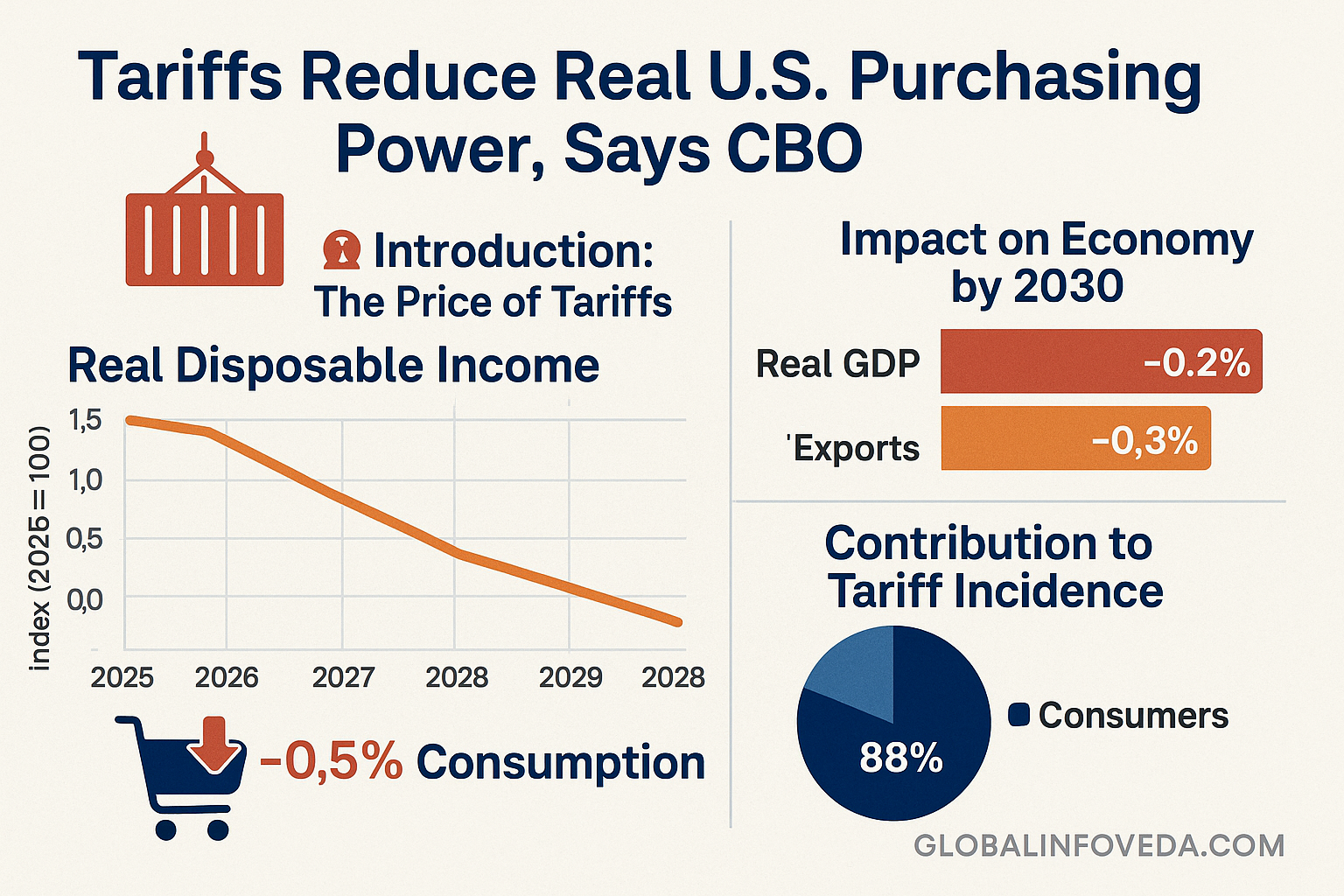Tariffs Reduce Real U.S. Purchasing Power, Says CBO
🏛️ Introduction: A Shrinking Wallet Effect
In its latest 2025 economic outlook, the Congressional Budget Office (CBO) warns that the new wave of tariffs is eroding U.S. household purchasing power at an accelerating pace. By driving up prices for both imported goods and domestically produced substitutes, tariffs are creating a cost-of-living squeeze that wages and salaries are failing to offset. This is not just a short-term annoyance—it is a structural drag on consumption, savings, and investment.
This blog provides an in-depth analysis of the CBO’s findings, highlighting the mechanics of this economic strain, sector-by-sector effects, historical parallels, and the long-term risks for inequality and economic resilience.
📊 Big Picture: The Real Income Squeeze
- CBO Estimate: Real household income fell 2.1% in 2024–25 as tariff-driven inflation outpaced wage gains.
- Price Increases: Electronics rose 5–8%, apparel surged 9–12%, and household goods climbed 7–10%.
- Consumption Slowdown: Real consumer spending growth dropped from 2.5% to 1.4% YoY.
📌 Key Data Points:
- Real wage growth: +1.0%, well below the 3.1% inflation rate.
- CPI for tariff-affected goods: +9.2% YoY.
- Household savings rate declined from 6.2% to 4.9%.
- Credit card debt reached an all-time high of $1.15 trillion, with delinquency rates rising.
- Household debt service ratio climbed to 10.5%, its highest since 2008.
🔍 Sectoral Impact Breakdown
1. Electronics
- Tariffs on semiconductors, screens, and batteries raise production costs.
- Smartphone upgrade cycles lengthened from 2.8 to 3.4 years.
- Refurbished electronics sales rose 18% YoY, signaling a shift in consumer behavior.
2. Clothing & Footwear
- Apparel inflation disproportionately hits low- and middle-income households.
- Increased reliance on discount retailers, resale platforms, and thrift stores.
- Partial production shifts to tariff-exempt countries help, but supply remains constrained.
3. Household Goods
- Furniture, appliances, and home improvement tools face higher input costs.
- Consumers delay big-ticket purchases, pressuring manufacturers and retailers.
- Rental and leasing options for appliances see a 22% YoY growth.
4. Indirect Sectors
- Logistics and retail experience inventory delays and reduced turnover.
- Service industries dependent on discretionary spending—such as dining and travel—see slower growth.
📊 Extended Comparison Chart: Tariff Impact on Purchasing Power
| Category | Price Increase | Consumption Effect | Long-Term Trend |
|---|---|---|---|
| Electronics | +5–8% | Slower upgrade cycles | Growth in refurbishing & repair services |
| Clothing/Footwear | +9–12% | Shift to discount/second-hand markets | Decline in mid-tier retail viability |
| Household Goods | +7–10% | Postponed big-ticket purchases | Rise in rentals & service-based models |
💵 Economic and Social Implications
- Erosion of Consumer Confidence: Fewer large purchases, even among higher-income households.
- Rising Credit Dependence: Short-term borrowing replaces income growth as a consumption driver.
- Savings Depletion: Households dip into emergency funds, weakening financial safety nets.
- Small Business Pressure: Reduced demand for non-essential goods tightens margins.
- Inequality Deepens: Lower-income households spend a higher share of income on tariff-affected essentials.
📈 Historical Context
- 1980s U.S.-Japan Trade Tensions: Similar income erosion in targeted consumer sectors.
- 2018–2019 Tariff Rounds: Demonstrated rapid price pass-through from importers to consumers.
- COVID-19 Supply Chain Shocks: Illustrated how global disruptions amplify domestic inflation.
🏛️ Policy & Relief Measures
1. Targeted Tariff Rollbacks
- Exempt essential goods like basic clothing, electronics, and home staples.
2. Wage Support & Tax Relief
- Expand EITC, introduce inflation-indexed wage subsidies, and provide tax credits for essential goods.
3. Boost Domestic Productivity
- Invest in manufacturing automation, renewable energy, and localized supply chains to reduce reliance on imports.
4. Debt Relief & Credit Regulation
- Cap credit card interest rates and expand refinancing options for households under strain.
5. Consumer Price Stabilization Fund
- Government-led program to buffer sudden spikes in key goods categories.
🔮 Final Insight: Inflation Without Wage Lift
The CBO’s findings underline that tariffs, while potentially serving strategic trade goals, act as a hidden tax on consumers. When wage growth fails to match price increases, the result is a stealth reduction in living standards and a drag on long-term economic momentum. Without coordinated trade, wage, and consumer protection policies, the purchasing power erosion will continue to undercut both household stability and national economic resilience.
📡 Stay connected to GlobalInfoVeda.com for in-depth coverage of trade policy and its real-world economic consequences.
